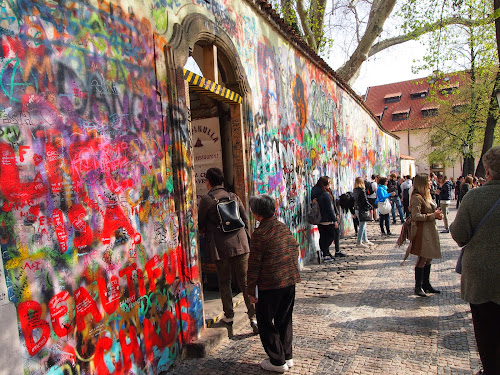Why is Prague so enjoyable to visit? What especially impressed us were the beauty and variety of its architectural styles and vistas, the compactness of the key interesting neighborhoods, and the exceptional friendliness of the people (whose English is pretty decent by international standards).
Among the visual delights of Prague are the graffiti on the John Lennon tribute wall started when he first died and attracting admirers from across the world (maybe you can make out two images of his face to the right of the doorway) and the sgraffiti (the illusion of three dimensions on a wall by applying layers of colored plaster) on a number of buildings in the area of Prague Castle.
Some areas of Prague reminded us of Brussels, with gorgeous Art Nouveau architecture, like this concert hall.
Right next door is the “Powder Tower,” a surviving gate from an old city wall that stored gunpowder for a few years in its storied past.
Whatever architectural style this is, we thought the forcefulness of it was impressive and that it is certainly from the twentieth century, given the gas mask in this sculpure (complete with pigeon spikes):
Indeed, we’ve never seen so much scupture decorating buildings in such a concentrated area as in Prague.
Around every corner, you don’t know what you will encounter. Turn one way and it’s the grandeur of the Hapsburgs at the castle. Venture down another street and you may see the charm of a restaurant courtyard or the spectacular clock at the center of the old town (with an Easter tree around the corner).
The city has, of course, a colorful past. Very few years were spent under the rule of locals, such as good King (actually, Prince) Wenceslas. A truly popular ruler, he was, alas, killed by his brother who took over on his death, although no streets have been named nor monuments erected in his brother’s honor. Here Prince Wenceslas presides once again over his city and Wenceslas Square, scene of most major political events of the last couple of centuries, including the Velvet Revolution in 1989.
There were other traditions for getting rid of rulers in the 15th and 17th centuries, such as throwing people out of windows. That’s where we got the word “defenestration,” i.e. out the old fenestra (Latin for window, of course), for this colorful means of regime change. Was it this window with what looks like a gangplank? No. This facade seems to be one Maria Theresa (grandmother of Marie Antoinette) put over some old architecture that didn’t go well with her decor. You can see the original look in that corner staircase. The windows through which history changed seem to have been on the other side of the castle so that the unfortunate dignitaries at least had a good view of the city on the way down.
Keeping to the theme of grisly ends, the tradition is to touch the statue of St. John of Nepomuck to ensure a return visit to Prague. St. John actually wasn’t very lucky. After he refused to divulge the secrets of the confessional under torture (it was the Queen he was protecting), his tongue was cut out and he was thrown from St Charles bridge. Coincidentally, that’s where you’ll find his statue, rubbed bright by all of those eager hands.
















